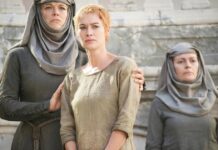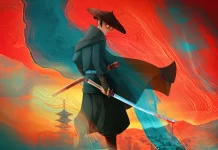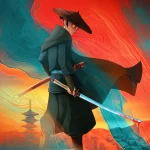When Magic Eye creator Tom Baccei welcomed executives from General Mills to the offices of his N.E. Thing Enterprises company in 1994, he led them to a mock-up cereal advertisement he had his employees put together. The board depicted a bowl of cereal and an ill-defined series of dots. When their eyes relaxed, the executives were able to make out the “hidden” message in the bowl: BUY ME.
“Oh, no, we can’t do that,” one executive said.
Baccei thought it was funny. By that point, his company needed no subliminal messaging in order to be successful. Sales of products featuring his wildly popular Magic Eye illustrations—which appeared to be two-dimensional abstract images until the viewer’s brain “switched” and perceived it as a three-dimensional image—were set to hit $100 million. Two Magic Eye books were on the New York Times bestseller list. Posters, coffee mugs, Hallmark cards, games, and postcards were emblazoned with the optical effect. Soon, they’d be on boxes of Apple Cinnamon Cheerios, too. Baccei knew they were all staring at a fad, but he was determined to make the most of it.
The Magic Eye images were based on principles that stretched as far back as 1828, when English physicist Sir Charles Wheatstone invented a device called the stereoscope that could merge two images together to create the illusion of depth. The trick amused royalty like Queen Victoria and Prince Albert. In 1959, a cognitive psychologist named Béla Julesz was able to take these illustrations, known as single image random dot stereograms, and make them visible to the naked eye. To achieve this, Julesz created one image of uniform, randomly distributed dots. One circular space would be shifted slightly in a second image. When viewed side-by-side, a circle appeared to “float” above the background. Julesz proved depth perception was a function of the brain, not the eye.
This stereopsis, or 3D effect, works because the brain essentially marries the two of them together to avoid experiencing double vision. Further work by visual neuroscientist Christopher Tyler in the 1970s condensed the illusion to a single image. But it would be Baccei who would turn this clever sleight of sight into a national phenomenon.
In the 1970s, Baccei was a bus driver for Green Tortoise, a purported “hippie” transportation company. He eventually moved on to work for Pentica Systems, a computer hardware company located just outside of Boston, Massachusetts. There, Baccei was tasked with advertising a MIME in-circuit emulator, which helped debug computer systems. Perhaps inevitably, he hired a mime for the ad.
The performer, Ron Labbe, happened to be a 3D photography enthusiast and brought along a stereo camera. When Baccei asked where he could get more information about the hobby, Labbe directed him to Stereo World magazine. There, Baccei saw one of the single image random dot stereograms and was amused by the visual trick. While it appeared to be nothing more than television static, focusing on it revealed circles and dots.
He decided to design one for Pentica, which “hid” the model number of a new product in the dotted image and prompted readers to contact them for a prize if they could see it. The ad became so popular that readers tore the page out of the magazine and pinned it up in offices or faxed it to associates.
Believing he was on to something, Baccei partnered with graphic artist Cheri Smith, who helped him create more involved images on a computer instead of the generic clip art he had been using. A Pentica co-worker named Bob Salitsky was able to refine the dots for a sharper image. Look at a picture of some tropical fish, for example, and a fish tank would appear. By 1991, Baccei was working on his own start-up, N.E. Thing Enterprises, and taking assignments for the illustrations. One of the images appeared in the American Airlines magazine American Way, where it caught the eye of Japanese businessmen. Soon, Baccei was working with Tenyo Co. Limited on a series of books and posters. While Baccei called the pictures Stare-e-os, the Amazing 3D Gaze Toys, the Japanese sold the images under the name Magic Eye.
That in-flight image also caught the attention of Mark Gregorek, a licensing agent who approached Baccei and told him there was incredible potential for partnering with other companies to create more Magic Eye content. Gregorek secured a deal with book publisher Andrews McMeel in 1993 as well as a variety of other licensees. Magic Eye was positioned to take off in America, though it’s not likely anyone anticipated what happened next.
After an initial 30,000 print run of the $12.95 Magic Eye book collection sold out, Andrews McMeel distributed 500,000 more copies. Both Magic Eye and Magic Eye II became bestsellers. N.E. Thing Enterprises—which officially changed its name to Magic Eye in 1996—made deals with many other companies for postcards, posters, a syndicated comic strip, and 20 million boxes of cereal. Mall kiosks, which were actually the product of a rival company named NVision Grafix, saw scores of people staring intently at the stereogram images. If one member of the group suddenly “got it,” the others would continue glaring in frustration. Those who couldn’t see the image—which, by one estimate, was up to 50 percent of people—were coached to put their nose close to the surface but have their eyes aimed further away. By slowly moving the page away, an image of surprising depth would appear. Magic Eye and similar products became a social obsession.
As revenues surpassed $100 million, Baccei knew that he couldn’t hold everyone’s attention forever. Like the Pet Rock, the Hula Hoop, and dozens of other fads, consumers would eventually have their attention diverted elsewhere. There were also the inevitable knock-offs, which might sell for as little as $5 for a poster compared to an official Magic Eye offering for $25. An attempt to humanize the pictures by having a corporate mascot, the wizard Wizzy Nodwig, failed to take off.
With business slowing in 1995, Baccei sold his portion of Magic Eye to graphic artist Smith and another partner, Andy Paraskevas. The company is still around, though it has refocused its attention on corporate clients who want to utilize the images for commercial purposes. You can check out images on their website, but Magic Eye cautions that the effect works best on the printed page.



















![[Book Review] The Blade Itself (The First Law Trilogy) by Joe Abercrombie](https://bendthekneegot.com/wp-content/uploads/2018/01/1516047103_maxresdefault-218x150.jpg)
















